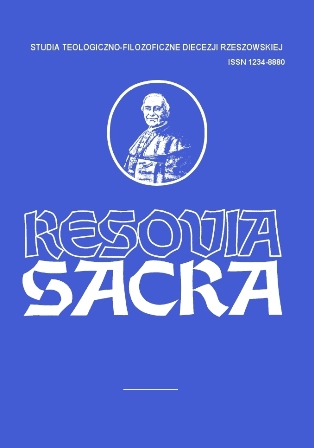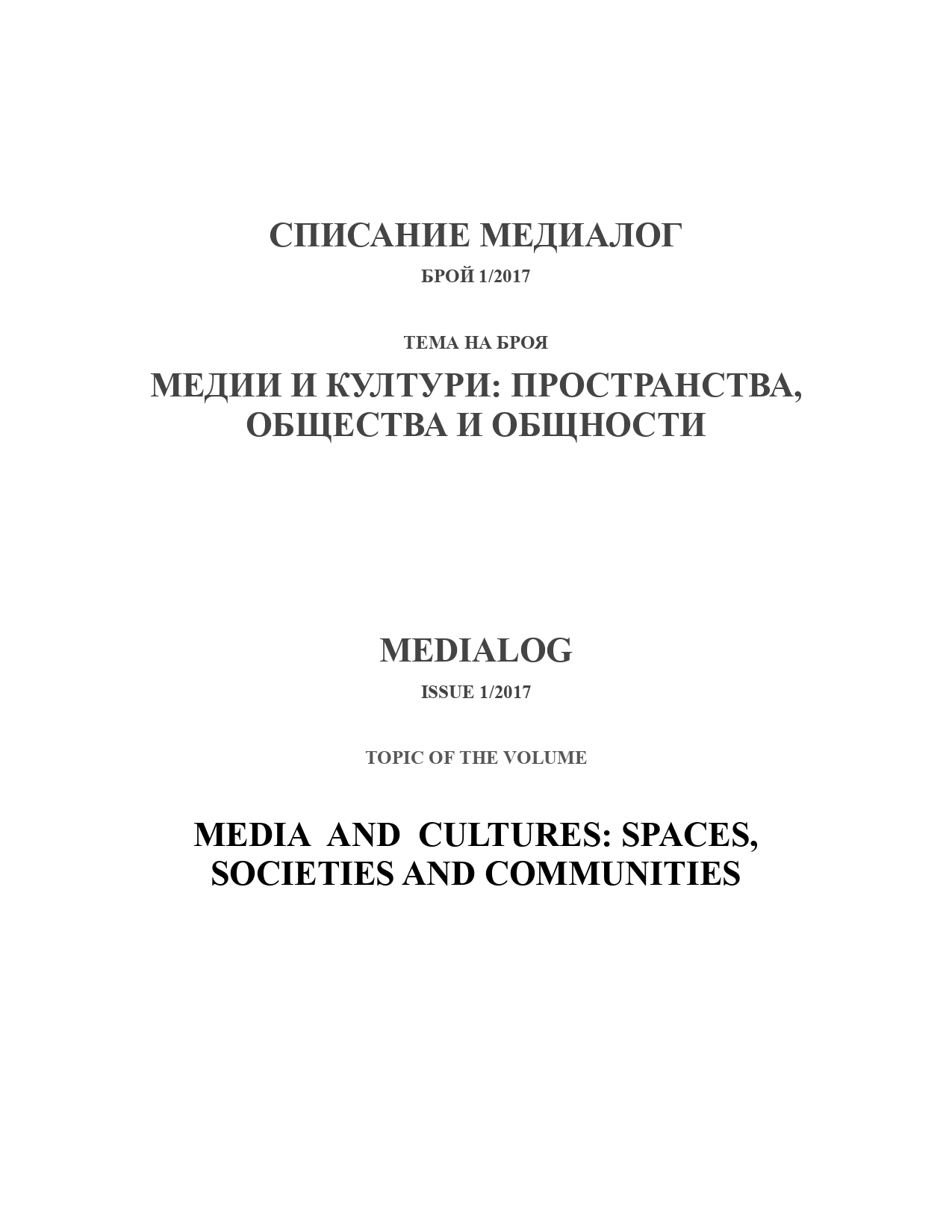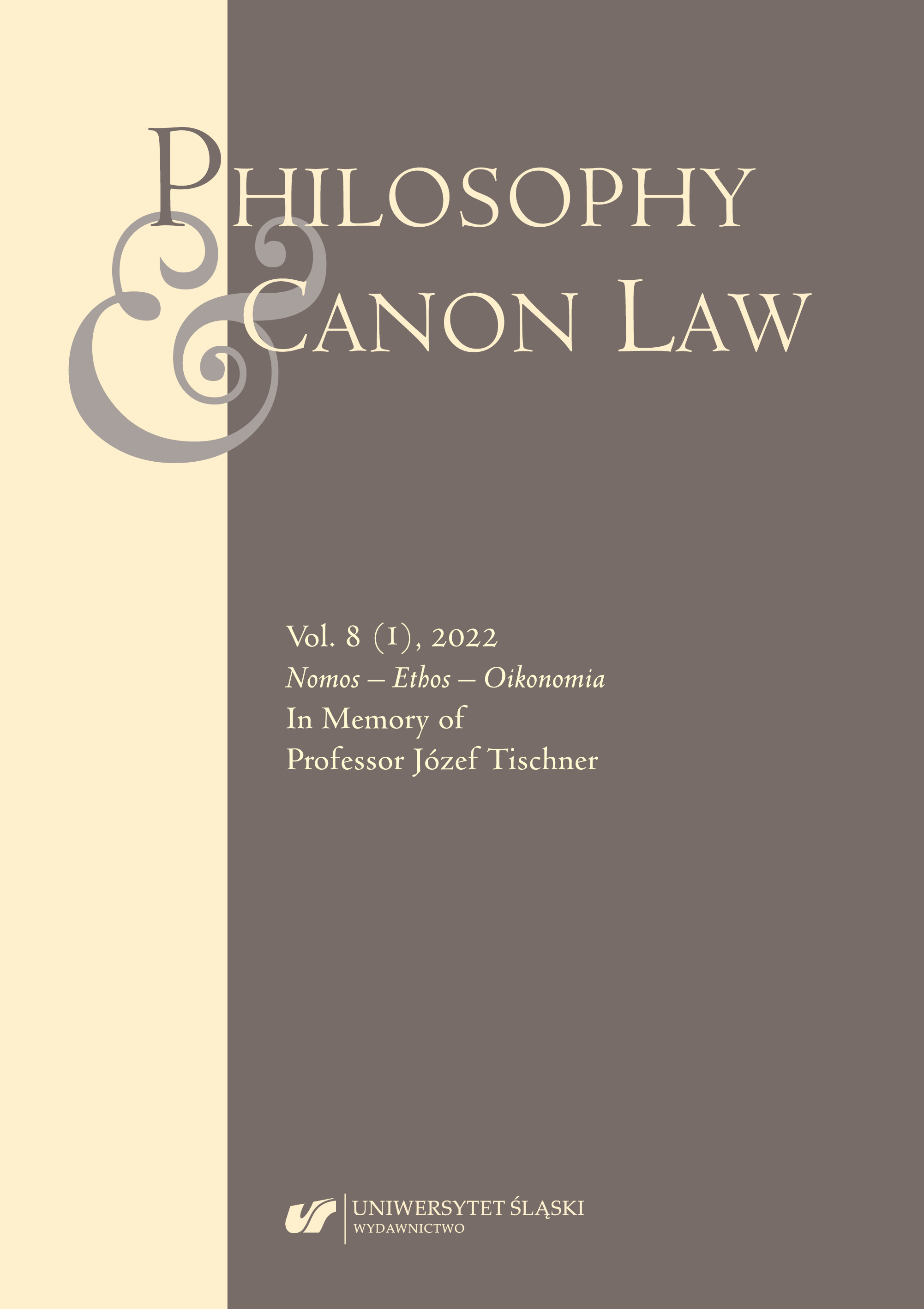
We kindly inform you that, as long as the subject affiliation of our 300.000+ articles is in progress, you might get unsufficient or no results on your third level or second level search. In this case, please broaden your search criteria.


The introductory article of the first issue of 'Medialog' journal presents the new academic journal, part of a new media culture portal. 'Medialog' is a journey into the media worlds. 'Medialog' is an invitation to dialogue addressed to academic researchers and university lecturers, PhD students and students; to all who are curious to understand something more and different about media, communications and culture.
More...
The article explores the relation between education and learning as a means of its implementation and the new type of socio-historical inheritance at the end of the twentieth century, related to changes in the nature of scientific knowledge itself. In the emerging new pedagogical paradigm, the main task is the transition from a center of knowledge to culture-friendly learning, the intellectualization of the learning process, but also its euro-denomination, is becoming more and more intense. It raises the issue of changes in values and new cultural realities in the process of communication, which builds a new type of the whole personality whose mentality unites culture and education. Innovative approaches to humanistic pedagogy and practice are aimed at developing the principles of developing learning, collaboration and creativity.
More...
The advancement of science and the change of moral norms in a market-driven society not only generate prosperity but also challenge the future of humankind. Most of the changes and problems in the environment can be foreseen if we turn to the knowledge that we acquire through ecology not only as an interdisciplinary but also as a transdisciplinary science. It is of no less important though that this knowledge should be rationalized in accordance to values and moral norms – in terms of a philosophy that explains the meaning of the technologically changing world and the consequences for the future.
More...
Stereotypes and prejudices influence our daily lives, and in certain circumstances we operate withthem, despite the fact that we think we are free of prejudices. Not infrequently, they can becomebarriers in the communication, knowledge and acceptance of those around us; from this point ofview, we must have the readiness to deal with our own prejudices, so that we do not reachsituations of discrimination, marginalization, rejection or exclusion of some people on subjectivegrounds, influenced by stereotypes and misrepresentations about others (we often observe that ourattitude and behavior towards a stranger is influenced by the way that person looks or is dressed).This study is based on stereotypes. It aims to identify attitudes and behaviors that perpetuate orchallenge gender stereotypes in education. We will see what is stereotype, prejudice,discrimination, we will go a little bit on gender, cultural and language stereotypes, and finally wewill see concrete examples within a school unit. This theme has become a problem of society.Stereotypes give rise to prejudices, and further discrimination. And during this research I noticedthat since we were born, these things have been instilled in us.
More...
Apart from the violence covered by the press by informative broadcasts at peak audiencehours, we found it was extremely important to debate this topic in the pre-universityenvironment, especially in high school classes, where students are easily trained in theeducation for life. A first argument to debate this topic is the one provided by televisionchannels, radio shows and articles written in newspapers by non-professionals. In order toprotect them from the aggressive media exposure to school-based conflicts, we thought toprovide pictures or movies with a strong social and emotional impact to raise awareness ofthe bad actions in the everyday life of students.A second argument is that we have tried to see the causes of class conflicts, to find solutionsin diagnosing the occurrence of conflicts between classes, then to put into practice methodsand techniques for solving conflicts in the form of a game, for the students to finally realizethat some conflicts can be quenched from the beginning by treating indifferently gestures thatcan be tolerated and accepted at the same time.
More...
Emphasizing a keen interest in the corporeal/bodily in its dynamics and its cognitive characteristics, the authors show that the appeal to the corporeal as a cognitive option changes the understanding and perception of such traditional phenomena as the world, reality, space, things. The proposition that the subject constructs the world, and our bodily experience is determined by the word and constructed by discursive contexts, looks incomplete: its limited nature requires some additions. The authors underline that the study of human sensual cognitive capabilities and the analysis of the cognitive map of the bodily forces us to pay attention to embodied rationality. Addressing it allows us to overcome constructivism, focused exclusively on the discourse of the word, because our intelligence was also shaped in accordance with the form of body action. The authors turned to the problem of mode the visibility of ethics and posed a provocative question as follows: can the cognitive abilities of the bodily act as a basis for ‘construction the morality’ and occupy n equal position with verbal discourse? To solve this problem, the authors analyzed relevant scientific findings and their influence on the nature of the development of constructivist epistemology, studied the debate on the issue of ethics taking place among the representatives of constructivism, and, in particular, analyzed discussions on tools of the constructivism. At present, all ideas and works of constructivism must take into account bodily rationality as their obligatory component (in its general instrumental and methodological basis), and bodily rationality can serve as the basis for “constructing morality.”
More...
The article looks at the systematic attempts to transform the coronavirus epidemic into a state ideology similar to the Marxist-Leninist one, within the former Eastern Bloc. However, the current ideological attempts do not rely on repressive state apparatuses. They are voluntarily accepted. What operates behind this voluntary acceptance is a public communication strategy based on the war model and in a regime of hyper-information, i.e. infodemic. It is a strategy with a pyramidal structure, the top of which is held by the state government, reframed as “good” power. For the first time at the base of an ideology is not a historic event, but a natural one. This gives such a nature-based ideology the chance to exploit and govern the most basic existential fears of people. Furthermore, the article is focused on the current Bulgarian political situation. However, the aforementioned pandemic’s ideological strategies and their influence in Bulgaria are placed in the broader context of the return of conservative ideologies and the destabilization of the liberal consensus in Europe and the States.The article looks at the systematic attempts to transform the coronavirus epidemic into a state ideology similar to the Marxist-Leninist one, within the former Eastern Bloc. However, the current ideological attempts do not rely on repressive state apparatuses. They are voluntarily accepted. What operates behind this voluntary acceptance is a public communication strategy based on the war model and in a regime of hyper-information, i.e. infodemic. It is a strategy with a pyramidal structure, the top of which is held by the state government, reframed as “good” power. For the first time at the base of an ideology is not a historic event, but a natural one. This gives such a nature-based ideology the chance to exploit and govern the most basic existential fears of people. Furthermore, the article is focused on the current Bulgarian political situation. However, the aforementioned pandemic’s ideological strategies and their influence in Bulgaria are placed in the broader context of the return of conservative ideologies and the destabilization of the liberal consensus in Europe and the States.
More...
This article aims to analyze the beginning of the transition from logos to myth. To incorporate the religious into his Enlightenment philosophical system, Schelling presents a reconstruction of myth. The conceptions of the religious consciousness of the Self from antiquity as presented. The myth embodies cultural reality and the history of self-consciousness, an idea that was later considered by Mircea Eliade. Myths evolve in parallel with human evolution. The need for the development of abstract thinking and the complex social environment presuppose the new mythology. Christianity in history appears as part of the mechanism of human development, which generally symbolizes the transition from mythology to Christianity. Theology must abstract mythologies from the purely divine, but together they participate in the formation of human consciousness.
More...
The article presents a critique of the commonly held assumption about the practical advantage of endurantism over perdurantism regarding the problem of future-directed self-concern of a person. The future-directed self-concern of a person crucially depends on the possibility of the right differentiation of diverging futures of distinct persons, therefore any theory of persistence that does not entail a special non-branching relation of a person to only their future self seems to be counterintuitive or unrealistic for practical purposes of personal persistence. I argue that this pragmatic rationale about future-directed self-concern is equally challenging for both theories of persistence. Moreover, I indicate, that both of these theories fall and stand on the practical feasibility of hidden ontological presuppositions about specific second-order notions of concerns of persons for their future.
More...
In this paper I present a new dimension for philosophical and scientific analysis of artifacts as anthropogenic abiotic objects along the lines of the distinction between real and virtual. This distinction purports to replace the classical opposition material–ideal as a better way of defining what an artifact is and as one more compatible with the scientific description and explanation of artefacts. The virtual relativity of the virtual artifacts is their relatedness to local language forms as an adequate coordinate system. The real relativity of artifacts is their relatedness to local and global human life processes. The article follows empirical science as a technique of studying artifacts, and subscribes to the anthropological paradigm.
More...
The main objective of this article is to demonstrate why despite the growing interest in justifying AI’s trustworthiness, one can argue for AI’s reliability. By analyzing why trustworthiness ethics in Nickel’s sense provides some well-grounded hints for rethinking the rational, affective and normative accounts of trust in respect to AI, I examine some concerns about the trustworthiness of Savulescu and Maslen’s model of moral AI as an adviser. Specifically, I tackle one of its exemplifications regarding Klincewicz’s hypothetical scenario of John which is refracted through the lens of the HLEG’s fifth requirement of trustworthy artificial intelligence (TAI), namely, that of Diversity, non-discrimination and fairness.
More...

The essay puts to the test Darwinian evolutionist theories, especially the key concepts of adaptation, natural selection and survival of the fittest, in the reading of several plots and fictions (some of them Ark-related animal fictions) concerned with evolution, trauma, adaptability, mimicry/mimesis and survival: Julian Barnes’s Flaubert Parrot and A History of the World in 10½ Chapters, Timothy Findley’s Not Wanted on the Voyage, Robert Kroetsch’s The Studhorse Man and John Fowles’s The French Lieutenant’s Woman. Weaving its critical argument with reference to several of Derrida’s reflections – on the impossibility of a pure origin, the proximity between commencement and commandment, the logic of obsequence, or relation between being and following (je suis), applied deconstructively to the traditional hierarchy between the human and the animal, mastery and monstrosity, and logos and bêtise, etc. – ‘Zo(o)graphies’ is structured in a series of interlinked tableaux, bestiaries as well as insets (Thomas Pynchon’s Gravity’s Rainbow, Jacques Derrida’s Glas). Following from the opening evocation of Peter Greenaway’s Vermeer-themed film A Zed & Two Noughts, which introduces the joint semantics of zographein: to paint from life, and zoon: animal, discreetly at work throughout, this study will eventually attempt to recast the problematic of the evolution of literature and literary forms as involution and regression.
More...
The article shows that in matters of philosophy of religion, when the sphere of interest of Wittgenstein went beyond logical and linguistic analysis, he attached special importance to a pragmatic approach to the interpretation of religious experience. Wittgenstein’s philosophico-religious studies were largely inspired by the events of his own life , as well as the ideas of individual thinkers, including the pragmatic philosopher William James. In Wittgenstein’s work one can find both a substantiation of the originality of religion and its impossibility of analysis from the standpoint of science, and a conviction in the expediency of religious experience in human life. It is revealed how Wittgenstein, analyzing the main manifestations of religious experience, pragmatically eliminated contradictions in the comprehension of knowledge about God (as unspeakable), pointed out the importance of transition from skepticism to belief as a basis for experience of absolute safety, took into account socio-practical aspects of various ethico-religious experiences such as feeling guilty. The author finds out how Wittgenstein interpreted the practical value of religious experience, analyzed the language of religion, as well as revealed its socio-psychological and ethical aspects.
More...
In this article, I intend to discuss the Arendtian conception of culture. In her influential essay “Crisis in Culture: Its Social and Its Political Significance,” Arendt argues that culture is at risk of disappearing under conditions of modernity. In her view, modernity is the age of mass society that leads to the destruction of culture and the development of mass culture. This is the situation Arendt has in mind when she speaks of a “crisis in culture,” a situation she describes as worldlessness. Culture, according to her, is a phenomenon of the world. Because of this conviction, argues Arendt, culture has a closer relationship to politics. The article is divided into two parts. In the first part, I explore Arendt's critical reflection on the modern attitude to culture. In the second part, I examine her analysis of the relationship between culture and politics. Throughout these parts, I suggest a reading of Arendt that illustrates her understanding of culture based on the authority of Greek and Roman thought and Kant’s Critique of Judgment.
More...
The present article examines Józef Tischner’s idea of upbringing (wychowanie) in establishing the new awareness of solidarity among the Polish workers and people through an awakening to conscience. The present moment served as a revolutionary alternative to socialism. I look at Tischner’s critique of Marxism and the central issue surrounding base and superstructure. Then I turn to his recovery of the Polish tradition of ethical ideals, especially in the person of Maximilian Kolbe and John Paul II. The text provides a detailed analysis of the chapter on upbringing in The Spirit of Solidarity. Tischner’s notion that upbringing is a personal bond established in trust to live in hope for improvement in mind and heart is placed in the context of the solidarity as a social bond establishing an ethical community transcending the political quest for power and the need to find an enemy. The text analyzes the various counterfeit forms of education in order to deepen our awareness of the meaning of authentic upbringing. Salient points of his teaching are discussed in conclusion.
More...
The essay explores the puzzling relationship between joy and the problems of postmodern culture, which affect the quality of our being in the world. Reflection on the precarious status of joy and its uncertain position in contemporary culture allows for a unique perspective on this relationship. The higher the political, economic and social stakes, the more the search for joy becomes a search for meaning, an essential nourishment for cultural forms. Such joy, filtered through our struggles with life’s challenges, compels us to examine the consequences of its absence (pain, suffering, joyless existence) and its manifestations in art (music), religion (Christianity), and philosophy (freedom). The power of joy lies in recognizing the inevitable imperfection of all solutions to our problems that do not include it as a fundamental component of life.
More...
This essay explores the philosophical implications inherent in Samuel Beckett’s most enigmatic and metonymic late theater work, Not I, even as he frequently abjured any interest in philosophy, which he claimed neither to read nor to understand. The play is profoundly ontological, however, and its metonymic stage image engages the classical philosophical conundrum of the relationship of the part, a piece or fragment, say, to the whole, an issue with which Beckett has at least been intrigued for most of his creative life.
More...
Mobile Journalism is often the subject of debate - is every journalistic assignment outside a studio or newsroom Mobile Journalism and whether the mobility of devices makes journalism mobile? This study presents another angle to the topic of Mobile Journalism, namely focusing on Smartphone Journalism. Why does one particular device stand out among the many technological innovations? The revolution in the field of journalism comes precisely from smartphones due to a specific reason – the liberalization of content distribution channels. These are the first devices in such a wide-scale use, where traditional media systems no longer control the channels for content to reach audiences. The article presents data, collected as part of the International Project: “Mobile Journalism Practice and Education in Central-East European Countries”
More...